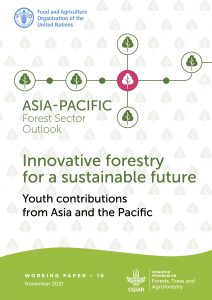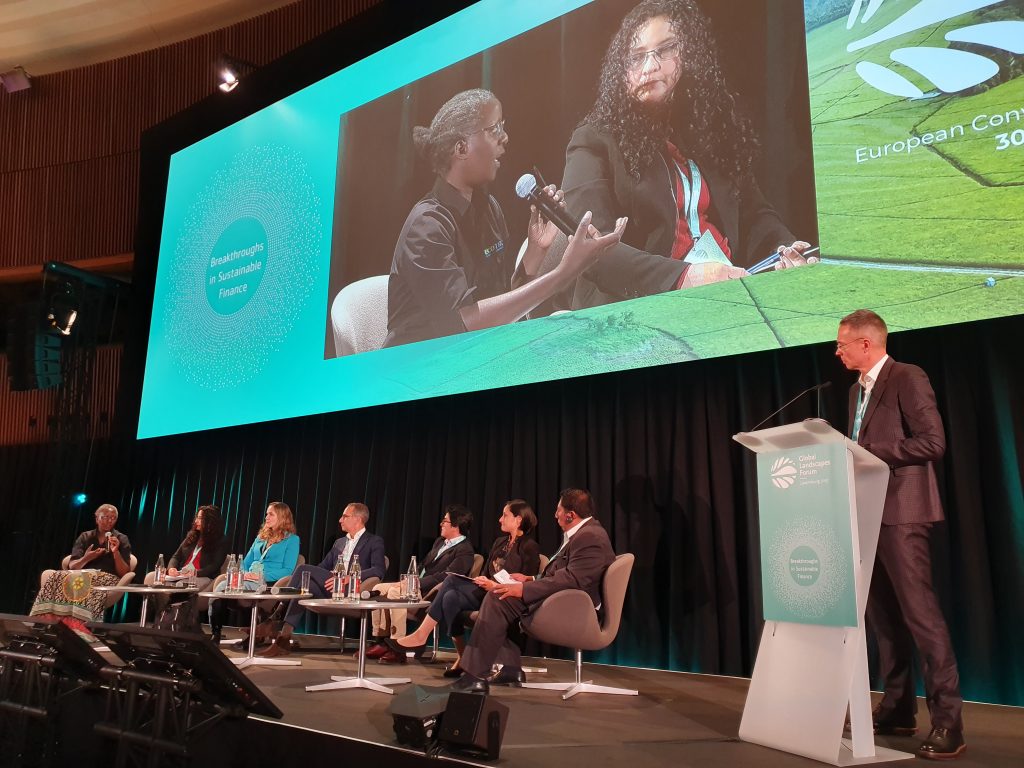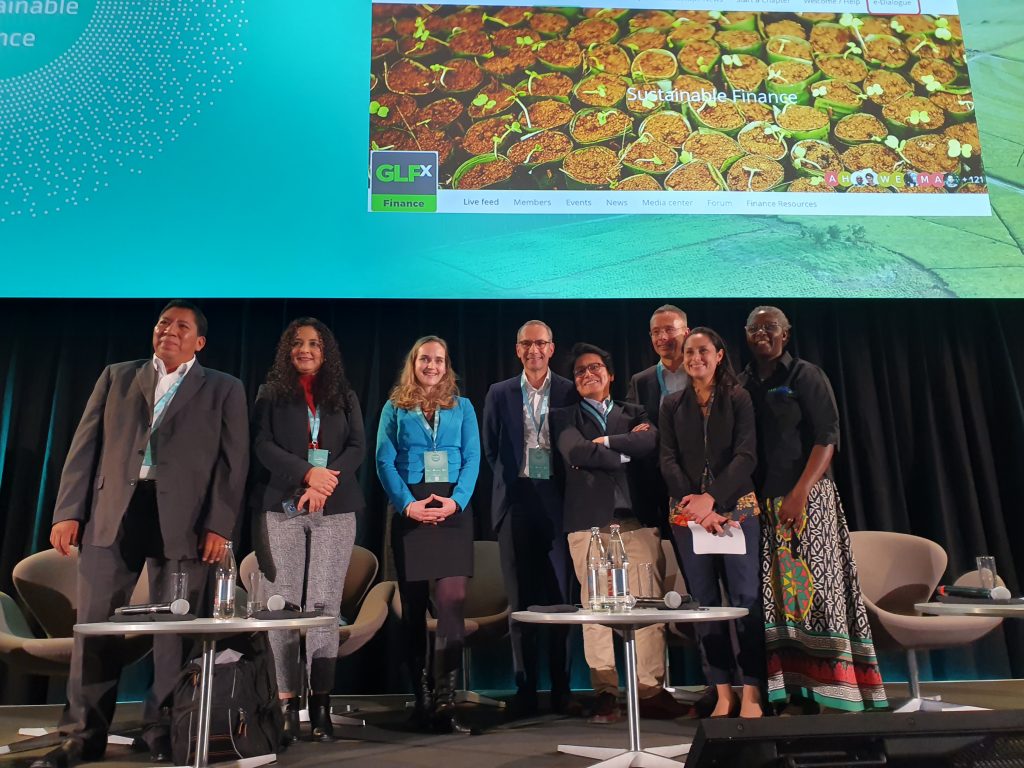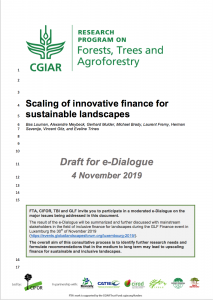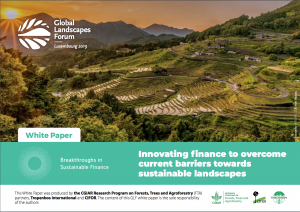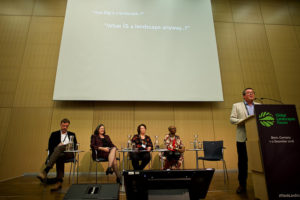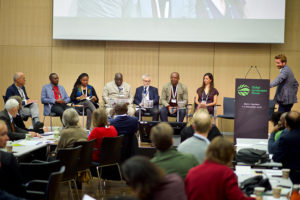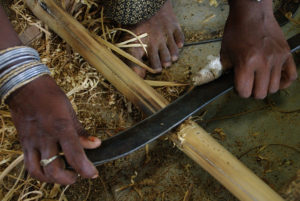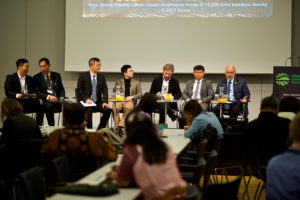Invaluable, but often overlooked, ecosystems produce micronutrient-rich foods
The Covid 19 pandemic is threatening food systems and global food security. According to the World Food Programme (WFP), which says the number of people facing crisis hunger is expected to almost double this year to 265 million.
Already, more than 820 million people do not get enough food to eat, and another 135 million people face acute hunger or starvation. Add to that, the economic destabilization caused by COVID-19, and another 130 million people are at risk of starvation by the end of 2020, says WFP.
The rapidity with which a health crisis transforms in a hunger crisis shows how fragile are our food systems to shocks of any nature. With this dire warning in mind, on June 3, the CGIAR Forests, Trees and Agroforestry Research Program (FTA) and partners will host a session in 2 parts at the Global Landscapes Forum (GLF), a three-day online conference where delegates will discuss the potential for sustainable food security in both the short and the long term through related research.
Forests, trees and agroforestry provide critical contributions to Food Security and Nutrition (FSN). All of these contributions are even more important in times of crisis.
Forests, trees and agroforestry provide nutrition dense foods such as fruits and nuts. They contribute to livelihoods and to the diversification of production and sources of income thus also increasing the resilience of households. They provide ecosystem services -water regulation, soil fertility and conservation, pollination, temperature regulation- that support farming systems and contribute to their adaptation to climate change. They are an essential component of sustainable and resilient food systems, contributing to the four dimensions of food security and nutrition both for the forest-dependent communities and globally.
The first part of the session will present some of the multiple ways that forests, trees and agroforestry contribute to Food Security and Nutrition, based on the most recent research results of FTA and its partners. The second part of the session will delve into the potential of forests, trees and agroforestry in increasing the resilience of food systems and stability of Food Security and Nutrition.
Participants will reflect on some of the specific strengths of farming systems, value chains and livelihoods that integrate trees in their systems amid crisis, including the current COVID-19 pandemic.
The whole session will feature a mix of short presentations, videos, interventions from actors on the ground, panel discussions and questions and answers with the audience. We look forward in having you join our session!
Please note that FTA has been offering free tickets for the GLF Bonn 2020 event to anyone wanting to share their story on how trees have been fundamental in times of crises (draughts, famines, covid-19, etc.) for their livelihoods. If you wish to participate – contact us at CGIARFORESTSANDTREES [at] CGIAR [dot] ORG
Full concept note available here
Full panel here
See also the agenda in the Conference Platform (need to register to access it)
Session 01 [14h00-15h30] – Session 02 [15h45-17h15]
Knowledge products
Session 1
Priority Food Tree and Crop Food Composition Database: http://www.worldagroforestry.org/products/nutrition/index.php/home
Publications
Dawson, I.K., McMullin, S., Kindt, R., Muchugi, A., Hendre, P., B Lillesø, JP., Jamnadass, R. (2019). Integrating perennial new and orphan crops into climate-smart African agricultural systems to support nutrition. The CSA Papers. https://doi.org/10.1007/978-3-319-92798-5_10
Fungo, R., Muyonga, J., Kabahenda, M., Kaaya, A., Okia, C. A., Donn, P., et al. (2016). Contribution of forest foods to dietary intake and their association with household food insecurity: a cross-sectional study in women from rural Cameroon. Public Health Nutr. 19, 3185–3196. doi: 10.1017/S1368980016001324
Golden, C. D., Fernald, L. C. H., Brashares, J. S., Rasolofoniaina, B. J. R., and Kremen, C. (2011). Benefits of wildlife consumption to child nutrition in a biodiversity hotspot. Proc. Natl. Acad. Sci. U.S.A. 108, 19653–19656. doi:10.1073/pnas.1112586108
HLPE. 2017. Sustainable forestry for food security and nutrition. A report by the High Level Panel of Experts on Food Security and Nutrition of the Committee on World Food Security, Rome. http://www.fao.org/3/a-i7395e.pdf
Ian K.Dawson, Andrew Barnes, Ramni Jamnadass, Eric Danquah, Rita H. Mumm, Steve Hoad, Fiona Burnett, Iago Hale, Kai Mausch, Prasad Hendre, Wayne Powell, Cesar Revoredo-Giha. (2019). Breeders’ views on the production of new and orphan crops in Africa: a survey of constraints and opportunities. ICRAF Working Paper No. 296. World Agroforestry. DOI: http://dx.doi.org/10.5716/WP19007.PDF
Ickowitz, A., Powell, B., Salim, M. A., and Sunderland, T. C. H. (2014). Dietary quality and tree cover in Africa. Glob. Environ. Change 24, 287–294. doi: 10.1016/j.gloenvcha.2013.12.001
Jamnadass, J., Place, F., Torquebiau, E., Malézieux, E., Iiyama, M., Sileshi, GW., Kehlenbeck, K., E. Masters, E., McMullin, S., Dawson, I.K. (2013). Agroforestry for food and nutritional security. Unasylva 241, Vol. 64, 2013/2 http://www.fao.org/3/i3482e/i3482e00.htm
Jamnadass, R., McMullin, S., Iiyama, M., Dawson, I.K. et al. (2015). Understanding the Roles of Forests and Tree-based Systems in Food Provision. In Vira, B., Wildburger, C., Mansourian, S. (eds.). (2015). Forests, Trees and Landscapes for Food Security and Nutrition. A Global Assessment Report. IUFRO World Series Volume 33. Vienna. 172 p. ISBN 978-3-902762-40-5, ISSN 1016-3263 http://www.cifor.org/publications/pdf_files/Books/BIUFRO1502.pdf
Lo, M., Narulita, S., Ickowitz, A. 2019. The relationship between forests and freshwater fish consumption in rural Nigeria. PLoS ONE, 14 (6): 0218038. https://doi.org/10.1371/journal.pone.0218038.
McMullin, S., Njogu, K., Wekesa, B. et al. (2019). Developing fruit tree portfolios that link agriculture more effectively with nutrition and health: a new approach for providing year-round micronutrients to smallholder farmers. Food Security. 11, 1355–1372 (2019). https://doi.org/10.1007/s12571-019-00970-7
Powell, B., Ickowitz, A., McMullin, S., Jamnadass, R., Padoch, C., Pinedo-Vasquez, M., Sunderland, T. (2013). The role of forests, trees and wild biodiversity for improved nutrition-sensitivity of food and agriculture systems. Expert Background Paper for ICN+ FAO, Rome, Conference paper for Joint FAO/WHO International Conference on Nutrition 21 Years later (ICN+21).
Powell, B., S. Thilsted, A. Ickowitz, C.Termote, T.Sunderland, and A. Herforth 2015. “Improving diets with wild and cultivated biodiversity from across the landscape” Food Security 7(3): 535-554.
Rasmussen, L. V., Fagan, M. E., Ickowitz, A., Wood, S. L. R., Kennedy, G., Powell, B., et al. (in press). Forest pattern, not just amount, influences dietary quality in five African countries. Global Food Security. doi: 10.1016/j.gfs.2019.100331
Rasolofoson, R. A., Hanauer, M. M., Pappinen, A., Fisher, B., and Ricketts, T. H. (2018). Impacts of forests on children’s diet in rural areas across 27 developing countries. Sci. Adv. 4:eaat2853. doi: 10.1126/sciadv.aat2853
Rosenstock, T., Dawson, I.K., Aynekulu, E., Chomba, S., Degrande, A., Fornace, K., Jamnadass, R., Kimaro, A., Kindt,R., Lamanna, C., Malesu, M., Mausch, K., McMullin, S., Murage, P., Naomi, N., Njenga, M., Nyoka, I., Paez Valencia, A.M., Sola, P., Shepherd, K. and Steward,P. (2019), A Planetary Health Perspective on Agroforestry in Sub-Saharan Africa, One Earth, 1(3), 330-344. https://doi.org/10.1016/j.oneear.2019.10.017
Rowland, D., Ickowitz, A., Powell, B., Nasi, R., and Sunderland, T. C. H. (2017). Forest foods and healthy diets: quantifying the contributions. Environm. Conserv. 44, 101–114. doi: 10.1017/S0376892916000151
Tata, C.Y., Ickowitz, A., Powell, B., Colecraft, E.K. 2019. Dietary intake, forest foods, and anemia in Southwest Cameroon. PLoS ONE, 14 (4): e0215281. https://doi.org/10.1371/journal.pone.0215281
Vira, B., Wildburger, C. & Mansourian, S. (eds). 2015. Forests, trees and landscapes for food security and nutrition. IUFRO World Series, 33. https://www.iufro.org/download/file/18901/5690/ws33_pdf/
Session 2
Publications
Amy Quandt, Henry Neufeldt & J. Terrence McCabe (2019) Building livelihood resilience: what role does agroforestry play?, Climate and Development, 11:6, 485-500, DOI: 10.1080/17565529.2018.1447903
Dawson, I.K.; Powell, W.; Hendre, P.; Bančič, J.; Hickey, J.M.; Kindt, R.; Hoad, S.; Hale, I.; Jamnadass, R. (2019) The role of genetics in mainstreaming the production of new and orphan crops to diversify food systems and support human nutrition New Phytologist 224: 37-54 DOI: https://doi.org/10.1111/nph.15895
De Leeuw, J.; Njenga, M.; Wagner, B.; Iiyama, M. (2014) Treesilience: an assessment of the resilience provided by trees in the drylands of Eastern Africa. ICRAF
Duguma L, Watson C, Nzyoka J, Okia C, Fungo B. 2019. The Migration-Environment Nexus: The Situation in Northwest Uganda.World Agroforestry: Nairobi.
Duguma, L.; Duba, D.; Muthee, K.; Minang ,P.; Bah, A.; Nzyoka, J.; Malanding, J. (2020) Ecosystem-Based Adaptation Through the Lens of Community Preferences ICRAF.
FAO and CIFOR. 2019. FAO Framework Methodology for Climate Change Vulnerability Assessments of Forests and Forest Dependent People. Rome. http://www.fao.org/3/ca7064en/CA7064EN.pdf
FAO. 2016. Climate change and food security: Risks and responses. FAO, Rome. http://www.fao.org/3/a-i5188e.pdf
FAO. 2017. Addressing Agriculture, Forestry and Fisheries in National Adaptation Plans – Supplementary Guidelines, by K. Karttunen, J. Wolf, C. Garcia and A. Meybeck. FAO, Rome. http://www.fao.org/3/a-i6714e.pdf
Fauzan, A.U.; Purnomo, H. (2012) Uncovering the complexity: An essay on the benefits of the value chain approach to global crisis studies-a case study from Jepara, Indonesia in Suter, C.and Herkenrath, M.. World Society in the Global Economic Crisis: Volume 2011: 149-169)
Gitz, V. & Meybeck, A. 2012. Risks, vulnerabilities and resilience in a context of climate change. In A. Meybeck, J. Lankoski, S. Redfern, N. Azzu & V. Gitz, eds. Building resilience for adaptation to climate change in the agriculture sector, pp. 19–36. Proceedings of a Joint FAO/OECD Workshop, 23–24 April 2012. Rome, FAO.
Havyarimana, D.; Muthuri, C.; Muriuki, J.; Mburu, D. (2019) Constraints encountered by nursery operators in establishing agroforestry tree nurseries in Burundi Agroforestry Systems 93: 1361-1375 DOI: https://doi.org/10.1007/s10457-018-0246-2
HLPE. 2017. Sustainable forestry for food security and nutrition. A report by the High-Level Panel of Experts on Food Security and Nutrition of the Committee on World Food Security, Rome. http://www.fao.org/3/a-i7395e.pdf
Ian K. Dawson, Andrew Barnes, Ramni Jamnadass, Eric Danquah, Rita H. Mumm, Steve Hoad, Fiona Burnett, Iago Hale, Kai Mausch, Prasad Hendre, Wayne Powell, Cesar Revoredo-Giha. 2019. Breeders’ views on the production of new and orphan crops in Africa: a survey of constraints and opportunities. ICRAF Working Paper No. 296. World Agroforestry. DOI: http://dx.doi.org/10.5716/WP19007.PDF
Kiros Meles Hadgu, Badege Bishaw, Miyuki Iiyama, Emiru Birhane, Aklilu Negussie, Caryn M. Davis, and Bryan Bernart, Editors. Climate-Smart Agriculture: Enhancing Resilient Agricultural Systems, Landscapes, and Livelihoods in Ethiopia and Beyond. 2019. World Agroforestry (ICRAF), Nairobi, Kenya.
Libert Amico, A.; Ituarte-Lima, C.; Elmqvist, T. (2019) Learning from social–ecological crisis for legal resilience building: multi-scale dynamics in the coffee rust epidemic Sustainability Science: 1-17 DOI: https://doi.org/10.1007/s11625-019-00703-x
Locatelli, B., Kanninen, M., Brockhaus, M., Colfer, C.J.P., Murdiyarso, D. and Santoso, H. 2008 Facing an uncertain future: How forests and people can adapt to climate change. Forest Perspectives no. 5. CIFOR, Bogor, Indonesia. https://www.cifor.org/publications/pdf_files/media/CIFOR_adaptation.pdf
Ndegwa G, Sola, P., Iiyama M, Okeyo I, Njenga M, Siko I., Muriuki, J.2020. Charcoal value chains in Kenya: a 20-year synthesis. Working Paper number 307. World Agroforestry, Nairobi, Kenya. DOI http://dx.doi.org/10.5716/WP20026.PDF
Sayer, J.A.; Endamana, D.; Ruiz Perez, M.; Boedhihartono, A.K.; Nzooh, Z.; Eyebe, A.; Awono, A. (2012) Global financial crisis impacts forest conservation in Cameroon International Forestry Review 14: 90-98 DOI: https://doi.org/10.1505/146554812799973172
Sinclair, F., Wezel, A., Mbow, C., Chomba, S., Robiglio, V., and Harrison, R. 2019. “The Contribution of Agroecological Approaches to Realizing Climate-Resilient Agriculture.” Rotterdam and Washington, DC. https://cdn.gca.org/assets/2019-09/TheContributionsOfAgroecologicalApproaches.pdf
Sinclair, F.; Rosenstock, T.S.; Gitz, V.; Wollenberg, L (2017) Agroforestry to diversify farms and enhance resilience. In Dinesh D, Campbell B, Bonilla-Findji O, Richards M (eds). 10 best bet innovations for adaptation in agriculture: A supplement to the UNFCCC NAP Technical Guidelines: 14-19)
Van Noordwijk M, Hoang MH, Neufeldt H, Öborn I, Yatich T, eds. 2011. How trees and people can co-adapt to climate change: reducing vulnerability through multifunctional agroforestry landscapes. Nairobi: World Agroforestry Centre (ICRAF). http://apps.worldagroforestry.org/sea/Publications/files/book/BK0149-11.pdf
Van Vliet, N.; Fa, J.E.; Nasi, R. (2015) Managing hunting under uncertainty: from one-off ecological indicators to resilience approaches in assessing the sustainability of bushmeat hunting. Ecology and Society 20: 7, DOI: https://doi.org/10.5751/ES-07669-200307
Vira, B., Wildburger, C. & Mansourian, S. (eds). 2015. Forests, trees and landscapes for food security and nutrition. IUFRO World Series, 33. https://www.iufro.org/download/file/18901/5690/ws33_pdf/
Vogt, N.D.; Pinedo-Vasquez, M.; Brondizio, E.S.; Rabelo, F.G.; Fernandes, K.; Almeida, O.T.; Riveiro, S.; Deadman, P.J.; Yue, Dou (2016 ) Local ecological knowledge and incremental adaptation to changing flood patterns in the Amazon delta; Sustainability Science 11: 611-623 DOI: https://doi.org/10.1007/s11625-015-0352-2
Further reading
https://forestsnews.cifor.org/59674/agricultural-intensification-has-fed-the-world-but-are-we-healthier?fnl=en
https://forestsnews.cifor.org/60872/superfood-from-cameroon-forest-scores-best-for-womens-health?fnl=en
https://forestsnews.cifor.org/53111/what-do-forests-have-to-do-with-food?fnl=en
https://forestsnews.cifor.org/58192/expansion-of-oil-palm-plantations-into-forests-appears-to-be-changing-local-diets-in-indonesia?fnl=en
https://forestsnews.cifor.org/52266/wild-nourishment?fnl=en
https://forestsnews.cifor.org/51201/forests-farming-and-food?fnl=en
https://www.foreststreesagroforestry.org/news-article/priority-food-tree-and-crop-food-composition-database/
http://www.worldagroforestry.org/blog/2019/11/29/year-round-micronutrients-ten-species-fruit-trees-are-better-just-few
http://www.worldagroforestry.org/news/using-agroforestry-address-seasonal-food-and-nutrient-gaps-communities-case-study-kenya
http://blog.worldagroforestry.org/index.php/2015/08/04/first-fruit-tree-portfolios-established-in-kenya-in-a-novel-approach-to-improve-year-round-nutrition/
https://www.economist.com/science-and-technology/2017/11/23/improving-the-plants-that-africans-eat-and-breeders-neglect
https://blog.worldagroforestry.org/index.php/2019/05/17/eradicating-hunger-through-the-african-orphan-crops-consortium/
